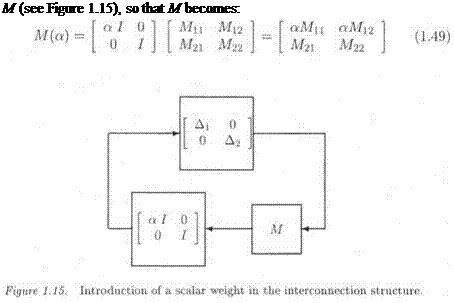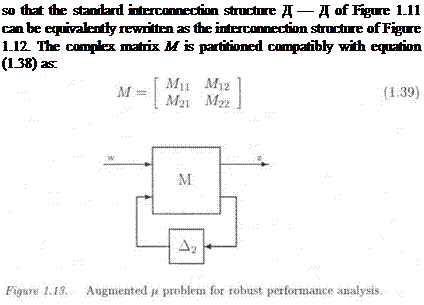SENSITIVITIES
|
|
Let Д = diад( Д 1 , Д s ) , where the Д s ’ s are most generally mixed structured model perturbations. Without loss of generality, the aim is to analyze the sensitivity of the s. s.v. ц{М) with respect to the first model perturbation Дх. Let the complex matrix M be partitioned as in equation (1.39), so that Mn corresponds to Ді and M22to Д2.
In the same way as in subsection 4.2, the model perturbation Дх is weighted by a scalar a, i. e. the model perturbation inside the interconnection structure becomes (see Figure 1.14):
|
|


 |
in Figure 1.14 is transfered from Д to
 |
||
Note that the weighting scalar a can be introduced in three different ways in the interconnection structure. The first one is equation (1.48). The second one is:
 |
and the associated value of M(a) is:
Even if these 3 solutions are equivalent, the third one is often chosen for numerical reasons (Braatz and Morari, 1991). The д sensitivity with respect to Ai is defined as:
|
|
It is easily proved that д(М(а)) is a non decreasing function of a, so that <5д is necessarily non negative. Moreover, it can be proved that the — sensitivities are well-defined and equal to the corresponding full derivatives, almost everywhere on any interval of variation of a (Braatz and Morari, 1991).
|
|
Indeed, ё ц can be interpreted as the derivative of /rwith respect to a (with the restrictions above). As a consequence, the higher the value of 6fi, the more critical the model perturbation Ді in the value of д. Consider as an illustration the case where — = 0 : this means that Ai has no influence on the value of д. Figure 1.16 illustrates this point. Let A = diag(Si,62), where the Si’s are real scalars. Figure 1.16 represents the space of the Si’s. Each point of the curve C corresponds to a value of the 0 : s, for which the matrix 0 — M A is singular. Conversely, all points strictly inside the domain, whose border is C, correspond to values of the Si’s, for which the matrix 1-М A is nonsingular. In an obvious way, the zero point (which corresponds to <5i = 0 and 82 = 0) belongs to this domain of nonsingularity.
1/д represents the size of the largest square in the space of the Si’s, which is centered on the zero point and inside which the matrix I — MA is guaranteed to be nonsingular. In Figure 1.16, the д sensitivity with respect to S2 is strictly positive, whereas the /x sensitivity with respect to S і is zero.
Remember finally that /x bounds are computed in practice instead of the exact value of ^x: see especially (Douglas and Athans, 1995) for the computation of the sensitivity of the /x upper bound by (Fan et al., 1991).

















